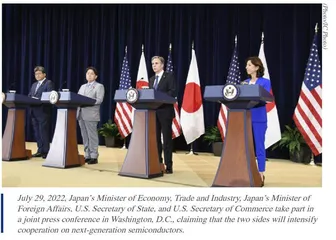Review of Biden’s Strategy of Tech Competition with China
作者: Wei Zongyou

Since taking office, Biden has gradually centered his China policy on strategic competition, identifying China as a strategic competitor and the most consequential geopolitical challenge. Unlike Donald Trump who focused on tariff and trade wars, the Biden administration sees technology as the key to strategic competition between China and the United States, believing that whoever wins in the technology competition will gain dominance of the international order in the post-Cold War era.
Strategic Goals for Tech Competition with China
A technology war against China was launched during the Trump presidency only as a “supplement” to the tariff and trade wars. After Biden took office, technology competition became part and parcel of strategic competition with China. For the Biden administration, it is not only about America’s economic competitiveness and military superiority, but also about whether the US can ultimately win the strategic competition that bears on its future. Based on such a strategic perception, the Biden administration has set three strategic goals.
First, enhance America’s technological competitiveness. Paul Scharre, Executive Vice President of the Center for a New American Security, observes that throughout history, technology has been critical to determining which countries dominate global politics, and that Western countries’ global colonial expansion could have not been possible without their technological strength. Since the end of World War II, as a leading economic and military power, the United States has also led the world in science and technology. It was second to none in terms of R&D inputs, sci-tech talent pool, publications, patents, and cutting-edge scientific discoveries. However, it is gradually losing its technological advantage since the second decade of the 21st century. In such key emerging technologies as AI, quantum technology, supercomputing, automation, 5G communications, and e-commerce, China is catching up or has even overtaken America. The Biden administration sees technological strength as the pillar of the country’s hegemony and the key to great power competition. To outcompete China, it needs to invest more in scientific research, and maintain its edge in high-end chips, AI, quantum computing, supercomputing, biotechnology, automation, next-generation communications, and other frontier technologies.
Second, maintain America’s military superiority. US hegemony is underpinned by military superiority which is largely attributed to its sci-tech strength. American scholar Chris Miller explains in the Chip War how America’s advantage in technology has led to its military superiority. In particular, in the current information war and the future intelligent warfare, strength in science and technology is critical to ensure military superiority. Recognizing the irreplaceable role of cutting-edge chips, AI, quantum technology, and supercomputing, the Biden administration believes whoever dominates these technologies will gain military advantage, and may turn it into battlefield superiority. Therefore, another strategic goal of the technology competition is to maintain America’s military superiority through enhanced sci-tech competitiveness.
Third, hobble China’s technological progress. Apart from enhancing technological competitiveness and maintaining military superiority, the Biden administration also aims to delay or hold back China’s technological progress. The policy address by National Security Advisor Jake Sullivan in September 2022 can be seen as a public announcement of this goal. Sullivan said in the speech that the US previously maintained a “sliding scale” approach to maintain comparative advantage, and stay a couple of generations ahead. That is not the strategic environment we are in today. Given the foundational nature of certain technologies, the US must maintain as large of a lead as possible.
The speech, which received little attention at the time, has been seen as a watershed or even the “Biden Doctrine” of America’s tech policy toward China. Since then, the US has tightened up policy in a bid to sabotage China’s technological advances, and ensure its “absolute superiority” over China.
A Three-Pronged Approach
To realize the three strategic goals which constitute the “Biden Doctrine” of containment, the Biden administration adopts a three-pronged approach in competing with China in science and technology.
First, the American government has increased investment in and support to the homegrown high-tech sector. The invisible hand of the market alone can hardly allocate adequate resources to cope with China’s rapid advances in high-tech. To maintain technological superiority, the visible hand of the government is needed as an intervention and additional support. Given the importance of advanced chips, artificial intelligence, quantum technology, biotechnology, and automation, and their role in modern military, the Biden administration makes it a top priority to invest in and support domestic R&D and production of high-end chips and other key technologies.
In August 2022, Joe Biden signed into law the CHIPS and Science Act, demonstrating his resolve to maintain US leadership in technology through hefty federal investment and substantial policy support. The Act directs $280 billion in spending over the next 10 years for scientific R&D. Some $52.7 billion is for semiconductor manufacturing, R&D, and workforce development to encourage “created in the US” and “made in the US”. The majority $200 billion is for R&D of key emerging technologies such as artificial intelligence and quantum technology. In addition, the government also enacted the Inflation Reduction Act which supports the development of clean energy technologies and industries, and encourages advanced manufacturing to flow back to the US with government subsidies.